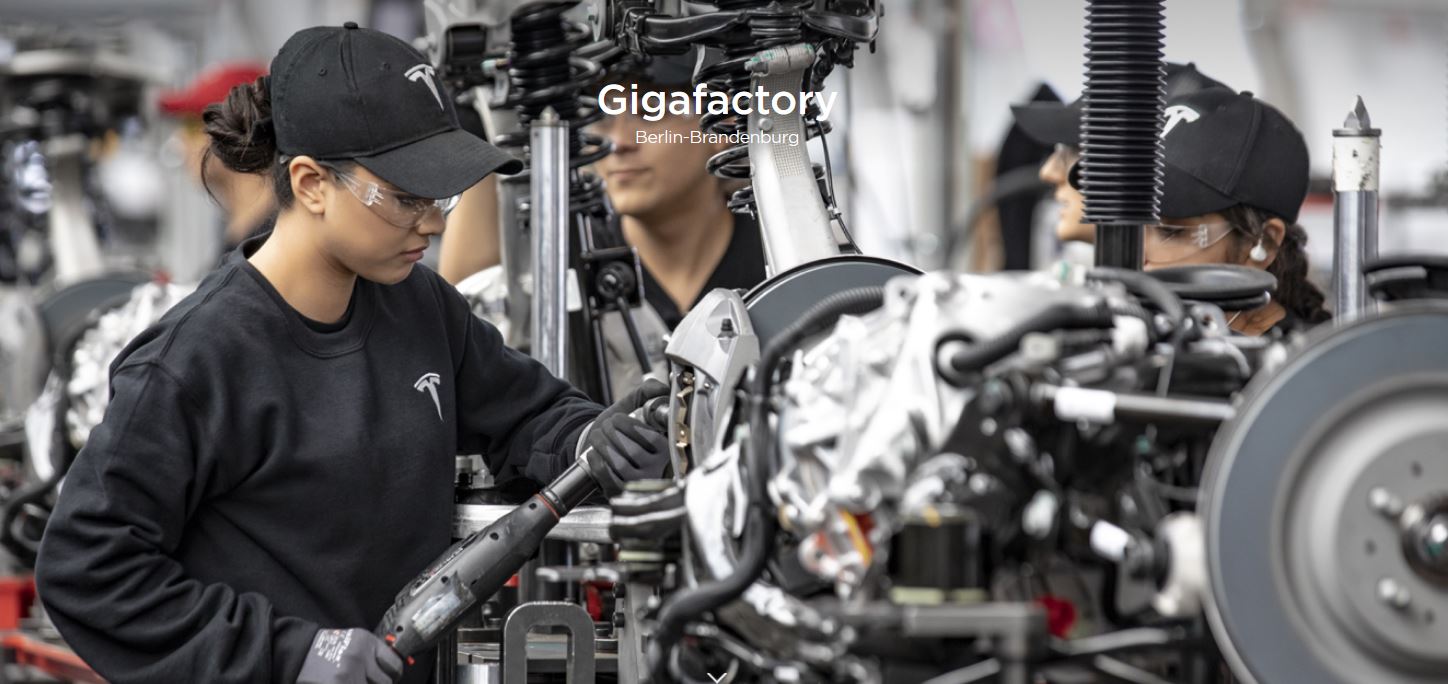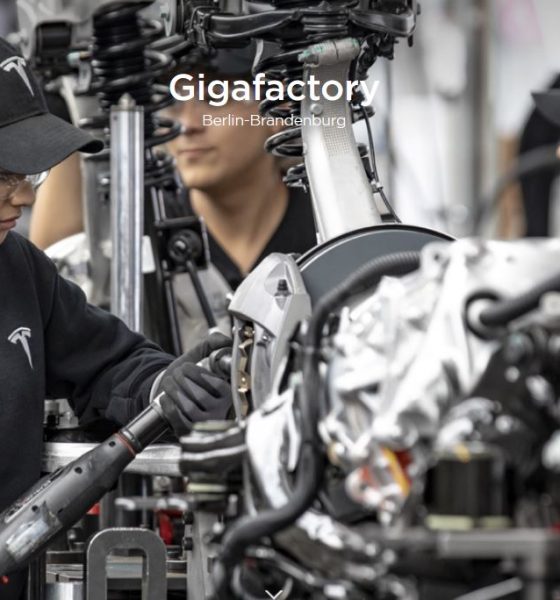

News
Tesla launches Giga Berlin website with focus on jobs and commitment to sustainability
Tesla launched the official website of Giga Berlin to showcase a multitude of career opportunities and the company’s strong commitment to sustainability for its first European factory.
With goals to create as much as 12,000 new jobs for residents of Grunheide, talent from across Germany and the rest of Europe, Tesla is looking to fill various positions in construction, manufacturing, engineering, and operations.
“Phase 1 will focus on production of Model Y, with a target capacity of 10,000 vehicles per week. We estimate that during Phase 1, we will employ up to 12,000 people, with roles being filled by local residents and employees from wider Europe. We want the best talent collaborating and working together to achieve the mission,” Tesla wrote on its new Giga Berlin website.
In addition to the various positions that Tesla seeks to hire for construction of its factory are manufacturing and engineering roles that will be focused on production line design as well as vehicle manufacturing.
Tesla is looking to form a team of professionals that will help “create the factory of the future” at Giga Berlin. Among the job openings is a position for a stamping production manager who will oversee the designing and building of new tooling for the production line. Tesla is also looking to hire chemical engineering leads who can help “create novel detailed designs for a wide range of systems from electrolyte to high purity water,” a position that can be crucial in the planned battery cell production at Giga Berlin.
The new positions in Germany further bolster Tesla’s strong presence in Europe as an employer. The company already has a strong workforce at its Model S and Model X assembly facility in Tilburg in the Netherlands, as well as at the Tesla Grohmann Automation in Prum, Germany. These facilities account for around 5,500 workers.
Tesla plans to begin construction of the Giga Berlin by mid-March and begin production as early as July 2021. In January, the Tesla board has approved the purchase agreement of the Grunheide property for about $45 million and is awaiting the second appraisal of an independent party. The electric car manufacturer has also started submitting documents needed to process a grant that can amount to 100 million to help fund the construction of Giga Berlin.
Earlier this week, the clearing of trees on the Giga Berlin build site was put on hold by court order after an environmental group lodged a complaint. Tesla has promised since the start to comply with all the rules in Germany and to focus on sustainability. It has outlined recently the environmental control measures it is taking to abide by the strict rules in the country such as relocation of wildlife from the forest. The Silicon Valley-based carmaker also put these things in the spotlight on its Giga Berlin website where it messages its commitment to improving the environment near Giga Berlin and the rest of the state of Brandenburg by collaborating with experts, environmental groups, residents, and German authorities.
Tesla will be replanting an area three times the size of its factory plot and has, so far, identified potential mass tree planting zones in Brandenburg an der Havel, Baruth/Mark, and Baad Saarow.
Giga Berlin will also install solar in a bid to help achieve the country’s “Energiewende” goals. Energiewende is the planned transition of Germany to a nuclear-free economy and expand the usage of renewable energies. The country aims to cut its greenhouse gas emissions by 40% this year, by 55% in 2030 and up to 95% come 2050 compared to the GHG levels in the 1990s.
On Wednesday, the Minister for Economic Affairs Jorg Steinbach will issue an update on the state of preparations for Giga Berlin during a meeting of the Economic Committee in the State Parliament.
Recently, Federal Minister of Economics Peter Altmaier voiced his support for the speedy construction of Giga Berlin, pointing out that any delay defeats the purpose of climate protection.
“The construction of the Tesla automobile plant in Brandenburg has been of great importance for more climate protection and one of the most important industrial settlements in the new federal states for a long time,” Altmaier said.

News
Tesla China quietly posts Robotaxi-related job listing
Tesla China is currently seeking a Low Voltage Electrical Engineer to work on circuit board design for the company’s autonomous vehicles.

Tesla has posted a new job listing in Shanghai explicitly tied to its Robotaxi program, fueling speculation that the company is preparing to launch its dedicated autonomous ride-hailing service in China.
As noted in the listing, Tesla China is currently seeking a Low Voltage Electrical Engineer to work on circuit board design for the company’s autonomous vehicles.
Robotaxi-specific role
The listing, which was shared on social media platform X by industry watcher @tslaming, suggested that Tesla China is looking to fill the role urgently. The job listing itself specifically mentions that the person hired for the role will be working on the Low Voltage Hardware team, which would design the circuit boards that would serve as the nervous system of the Robotaxi.
Key tasks for the role, as indicated in the job listing, include collaboration with PCB layout, firmware, mechanical, program management, and validation teams, among other responsibilities. The role is based in Shanghai.
China Robotaxi launch
China represents a massive potential market for robotaxis, with its dense urban centers and supportive policies in select cities. Tesla has limited permission to roll out FSD in the country, though despite this, its vehicles have been hailed as among the best in the market when it comes to autonomous features. So far, at least, it appears that China supports Tesla’s FSD and Robotaxi rollout.
This was hinted at in November, when Tesla brought the Cybercab to the 8th China International Import Expo (CIIE) in Shanghai, marking the first time that the autonomous two-seater was brought to the Asia-Pacific region. The vehicle, despite not having a release date in China, received a significant amount of interest among the event’s attendees.
Elon Musk
Elon Musk and Tesla AI Director share insights after empty driver seat Robotaxi rides
The executives’ unoccupied tests hint at the rapid progress of Tesla’s unsupervised Robotaxi efforts.

Tesla CEO Elon Musk and AI Director Ashok Elluswamy celebrated Christmas Eve by sharing personal experiences with Robotaxi vehicles that had no safety monitor or occupant in the driver’s seat. Musk described the system’s “perfect driving” around Austin, while Elluswamy posted video from the back seat, calling it “an amazing experience.”
The executives’ unoccupied tests hint at the rapid progress of Tesla’s unsupervised Robotaxi efforts.
Elon and Ashok’s firsthand Robotaxi insights
Prior to Musk and the Tesla AI Director’s posts, sightings of unmanned Teslas navigating public roads were widely shared on social media. One such vehicle was spotted in Austin, Texas, which Elon Musk acknowleged by stating that “Testing is underway with no occupants in the car.”
Based on his Christmas Eve post, Musk seemed to have tested an unmanned Tesla himself. “A Tesla with no safety monitor in the car and me sitting in the passenger seat took me all around Austin on Sunday with perfect driving,” Musk wrote in his post.
Elluswamy responded with a 2-minute video showing himself in the rear of an unmanned Tesla. The video featured the vehicle’s empty front seats, as well as its smooth handling through real-world traffic. He captioned his video with the words, “It’s an amazing experience!”
Towards Unsupervised operations
During an xAI Hackathon earlier this month, Elon Musk mentioned that Tesla owed be removing Safety Monitors from its Robotaxis in Austin in just three weeks. “Unsupervised is pretty much solved at this point. So there will be Tesla Robotaxis operating in Austin with no one in them. Not even anyone in the passenger seat in about three weeks,” he said. Musk echoed similar estimates at the 2025 Annual Shareholder Meeting and the Q3 2025 earnings call.
Considering the insights that were posted Musk and Elluswamy, it does appear that Tesla is working hard towards operating its Robotaxis with no safety monitors. This is quite impressive considering that the service was launched just earlier this year.
Elon Musk
Starlink passes 9 million active customers just weeks after hitting 8 million
The milestone highlights the accelerating growth of Starlink, which has now been adding over 20,000 new users per day.

SpaceX’s Starlink satellite internet service has continued its rapid global expansion, surpassing 9 million active customers just weeks after crossing the 8 million mark.
The milestone highlights the accelerating growth of Starlink, which has now been adding over 20,000 new users per day.
9 million customers
In a post on X, SpaceX stated that Starlink now serves over 9 million active users across 155 countries, territories, and markets. The company reached 8 million customers in early November, meaning it added roughly 1 million subscribers in under seven weeks, or about 21,275 new users on average per day.
“Starlink is connecting more than 9M active customers with high-speed internet across 155 countries, territories, and many other markets,” Starlink wrote in a post on its official X account. SpaceX President Gwynne Shotwell also celebrated the milestone on X. “A huge thank you to all of our customers and congrats to the Starlink team for such an incredible product,” she wrote.
That growth rate reflects both rising demand for broadband in underserved regions and Starlink’s expanding satellite constellation, which now includes more than 9,000 low-Earth-orbit satellites designed to deliver high-speed, low-latency internet worldwide.
Starlink’s momentum
Starlink’s momentum has been building up. SpaceX reported 4.6 million Starlink customers in December 2024, followed by 7 million by August 2025, and 8 million customers in November. Independent data also suggests Starlink usage is rising sharply, with Cloudflare reporting that global web traffic from Starlink users more than doubled in 2025, as noted in an Insider report.
Starlink’s momentum is increasingly tied to SpaceX’s broader financial outlook. Elon Musk has said the satellite network is “by far” the company’s largest revenue driver, and reports suggest SpaceX may be positioning itself for an initial public offering as soon as next year, with valuations estimated as high as $1.5 trillion. Musk has also suggested in the past that Starlink could have its own IPO in the future.








